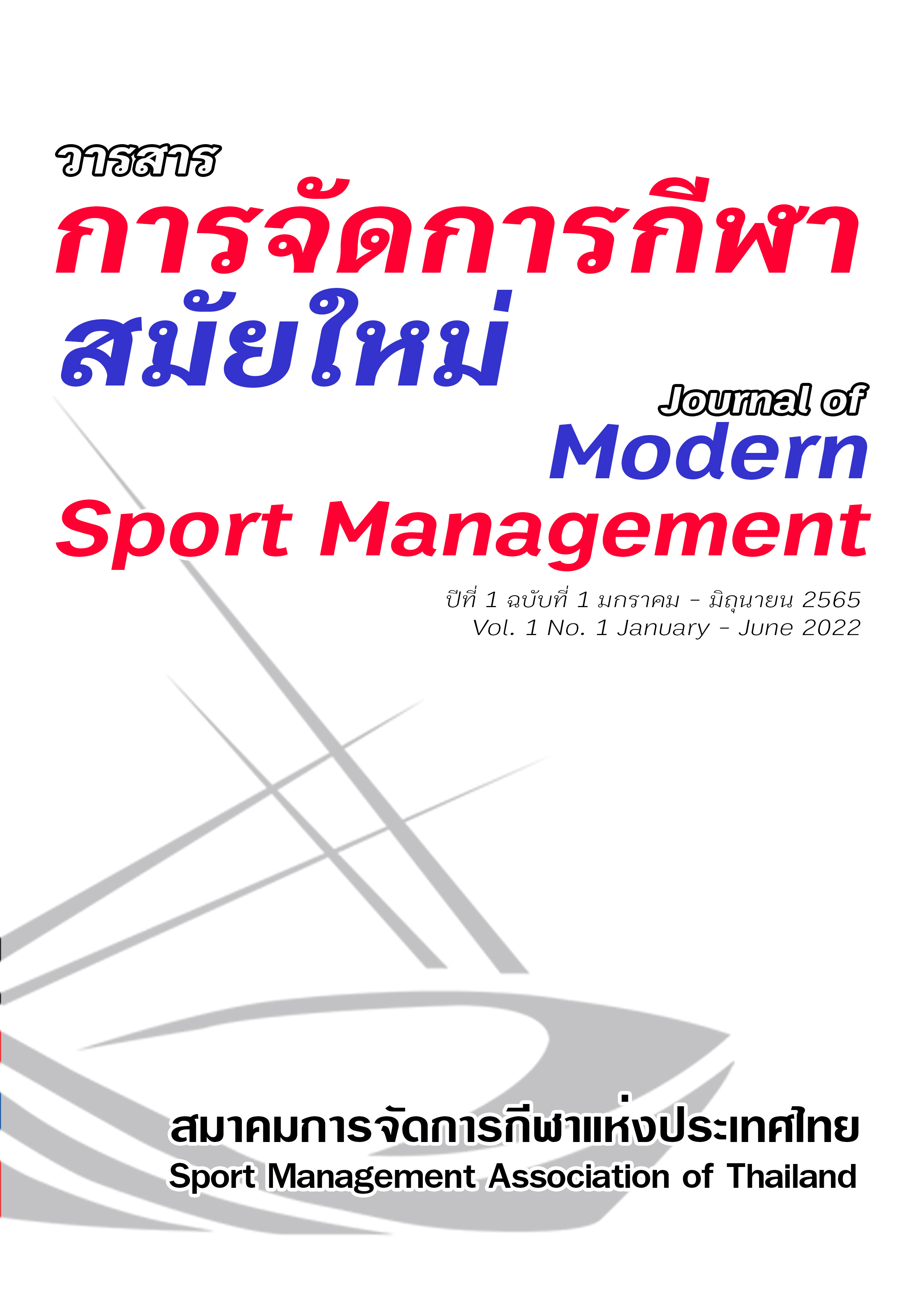ทิศทางการขับเคลื่อนอุตสาหกรรมการกีฬา ตามแผนพัฒนาการกีฬาแห่งชาติ ฉบับที่ 7 (พ.ศ. 2566-2570)
Main Article Content
บทคัดย่อ
บทความนี้ผู้เขียนมีจุดมุ่งหมายเพื่อศึกษาทิศทางการขับเคลื่อนอุตสาหกรรมการกีฬาตามแผนพัฒนาการกีฬาแห่งชาติ ฉบับที่ 7 (พ.ศ. 2566-2570) ในประเด็นพัฒนาที่ 5 ว่าด้วย การส่งเสริมและสนับสนุนการพัฒนาอุตสาหกรรมการกีฬา โดยทำการวิเคราะห์ และสังเคราะห์เอกสารที่เกี่ยวข้อง ซึ่งการที่จะพลิกโฉมอุตสาหกรรมการกีฬาของประเทศไทย ด้วยการสร้างมูลค่าเพิ่มของอุตสาหกรรมการกีฬานั้น ผู้มีส่วนได้ส่วนเสียทุกระดับในการพัฒนากีฬาของประเทศ จำเป็นต้องมีการนำทิศทางของอุตสาหกรรมการกีฬาของโลกที่มีการเปลี่ยนแปลง มาปรับในการพัฒนาขีดความสามารถในการแข่งขันของธุรกิจอุตสาหกรรมที่เกี่ยวข้องกับการกีฬา ให้มีความครอบคลุมทั้งภาคการผลิต ภาคการค้า และภาคบริการด้านการกีฬา รวมถึงการสนับสนุนการจัดกิจกรรมและมหกรรม การแข่งขันกีฬาระดับชาติและนานาชาติ และการจัดกิจกรรมกีฬาเชิงพาณิชย์ของภาคเอกชนและส่งเสริมการท่องเที่ยวเชิงกีฬา วัฒนธรรมที่เป็นอัตลักษณ์เชิงพื้นที่อย่างต่อเนื่อง และเพื่อให้การขับเคลื่อนอุตสาหกรรมการกีฬาของประเทศไทยสามารถบรรลุซึ่งวิสัยทัศน์ เป้าหมาย และมีแนวทางการดำเนินการที่มีความเป็นรูปธรรมอย่างแท้จริง
โดยในการขับเคลื่อนอุตสาหกรรมการกีฬาตามแผนพัฒนาการกีฬาแห่งชาติ ฉบับที่ 7 (พ.ศ. 2566-2570) ให้ประสบความสำเร็จผู้ที่มีส่วนเกี่ยวข้องทั้งในระดับนำนโยบาย ระดับการขับเคลื่อนแผน ระดับปฏิบัติการ ต้องมีความรู้ความเข้าใจในประเด็นอุตสาหกรรมการกีฬา การจัดการกีฬาแบบองค์รวม และระบบนิเวศ ของอุตสาหกรรมการกีฬา พร้อมทั้งสามารถเชื่อมโยงนโยบายด้านกีฬาทุกระดับของประเทศสู่การปฏิบัติ และมีแนวคิดของการขับเคลื่อนเชิงกลยุทธ์ มีกระบวนการดำเนินการ มีระบบติดตามการดำเนินงานอย่างต่อเนื่องเพื่อให้งานมีประสิทธิภาพและประสิทธิผลตามเป้าหมายที่กำหนดไว้
Article Details

อนุญาตภายใต้เงื่อนไข Creative Commons Attribution-NonCommercial-NoDerivatives 4.0 International License.
เอกสารอ้างอิง
CA International Information. (2019). Summary report of the follow-up assessment Implementation of the 6th National Sports Development Plan (BE 2560 2021), the first half of the plan. Bangkok: CA International Information.
Export-Import Bank of Thailand. (2015). Developing countries are not easy to move towards a consumer economy. Retrieved from https://www.ryt9.com/s/exim/2306106
Government Gazette. (2013). Professional Sports Promotion Act B.E. 2013. Volume 130.
Hums, M. A., Barr, C. A., & Gullion, L. (1999). The ethical issues confronting managers in the Sports industry. Journal of Business Ethics, 20(1), 51 - 66.
Ministry of Tourism and Sports. (2022). (Draft) National Sports Development Plan No. 7 (2023-2027). Bangkok: Ministry of Tourism and Sports.
Moen, R. (2009). Foundation and History of the PDSA Cycle. In Asian network for quality conference. Tokyo.
Montgomery, E. G., & Oladapo, V. (2014). Talent management vulnerability in global healthcare value chains: A general systems theory perspective. Journal of Business Studies Quarterly, 5(4), 173 - 189.
National Reform Steering Committee. (2016). Sports Industry Promotion. Bangkok: Secretariat of the National Reform Steering Assembly.
Pitts, B. G., & Stotlar, D. K. (2013). Fundamentals of Sports marketing. Morgantown, WV: Fitness Information Tech.
Pitts, B. G., Fielding, L. W., & Miller, L. K. (1994). Industry segmentation theory and the Sports industry: Developing a Sports industry segment model. Sports Marketing Quarterly, 3(1), 15 - 24.
Plunkett Research. (2009). Plunkett’s Sports industry almanac 2009. Houston, TX: Plunkett Research.
Scott, D. (1967). Some definitional suggestions for automata theory. Journal of Computer and System Sciences, 1(2), 187 - 212.
Shank, M. D., & Lyberger, M. R. (2015). Sports marketing: A strategic perspective. London: Routledge.
Tubtimcharoon, N. (2019). Situation Analysis for the Business of Small Hotels in Digital Economy Age in Thailand. WMS Journal of Management, 8(1), 1 - 9.
Wit Boon. (2022). Why is it so difficult to 'career' athletes in Thailand? Look at examples and find inspiration from the sports industry in US-Japan-UK. Retrieved from https://plus.thairath.co.th/topic/spark/101558


